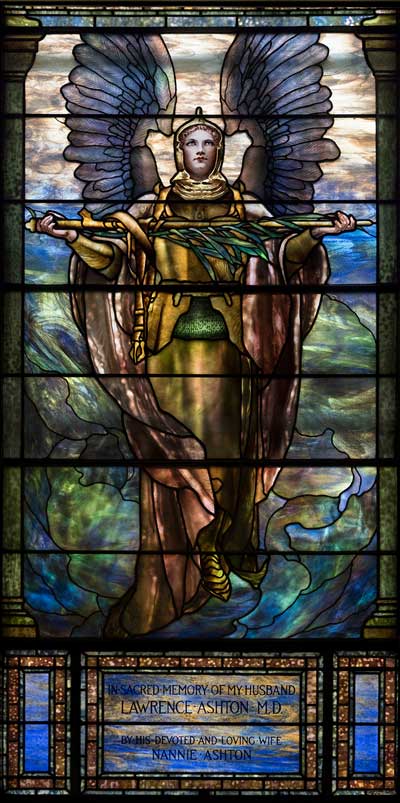
Stained Glass Windows— “Angel of Victory or Guardian of Medical Science”, 1917, Tiffany
The window honors Dr. Lawrence Ashton was one of the most prominent doctors of his day, born in King George in 1845 and received his medical education at the University of Washington, DC with further studies at the University of New York. He practiced in Fredericksburg for 15 years. As vice-president of the Virginia Medical Society for 8 years and president for one, he was the originator of the law to regulate the practice of medicine in Virginia. The window was dedicated by his wife, Nannie Green Ashton on September 27, 1917.
Nannie Green Ashton was the daughter of Duff Green. Duff Green was a prominent inspector of flour in Falmouth. In 1836, he constructed a cotton factory on the lot. It became the Elm Factory and powered by Steam and employed at least 40 people and continued even after his death. He also was a pewholder.
The window reflects Palm Sunday, the Sunday before Easter Sunday. Five days before the Passover, Jesus came from Bethany to Jerusalem. Jerusalem was the center of a local domination system, the center of the ruling class, the center of great wealth, and the center of collaboration with Rome.
Having sent two of His disciples to bring Him a colt of a donkey, Jesus sat upon it and entered the city. It was a planned demonstration – a counter-demonstration, political and an insult to the other side. The meaning of the demonstration is clear, for it uses symbolism from the prophet Zechariah in the Jewish Bible. According to Zechariah, a king would be coming to Jerusalem (Zion) “humble, and riding on a colt, the foal of a donkey” (Zechariah 9:9).
On the opposite side of the city, from the west was Pontius Pilate, the Roman governor of Idumea, Judea, and Samaria entered Jerusalem at the head of a column of imperial cavalry and soldiers. It was a procession proclaiming the might of the powers that be, there to ensure the security of the city during the festive time of the Passover.
The window depicts a triumphant angel in a rich gold robe with iridescent wings.
The angel is wearing a breastplate over armor and holding a sword and buckler which symbolizes the victory of the triumphant march into Jerusalem on Palm Sunday. The angel holds a gold staff with a palm, possibly representing the guardian angel of medical science, a suitable tribute to a doctor. The palms also symbolize the victory over death.
The flowers encircling the angel demonstrate Tiffany’s use of many textures and shapes of glass to envelop the angel which will cause a variety of colors throughout the day. This glass is called opalescent glass, glass with more than one color being fused at manufacture.
The folds in the robe use drapery glass. Glass while molten thrown onto an iron table and rolled into a disk. The glassmaker armed with tongs manipulated the mass and by taking hold of it from both ends like dough and pulling and twisting till it fell into folds.
This window may have been designed by Tiffany’s Frederick Wilson. A portraitist and cartoonist armed with an inexhaustible knowledge of Old and New Testament iconography, Wilson emerged as the firm’s most prolific and talented designer of figural windows and mosaic friezes from 1894 to 1923, producing the bulk of its church memorials until his departure in 1923.
The final window on this tour is the 3rd on the left or northern side, the Road to Emmaus.